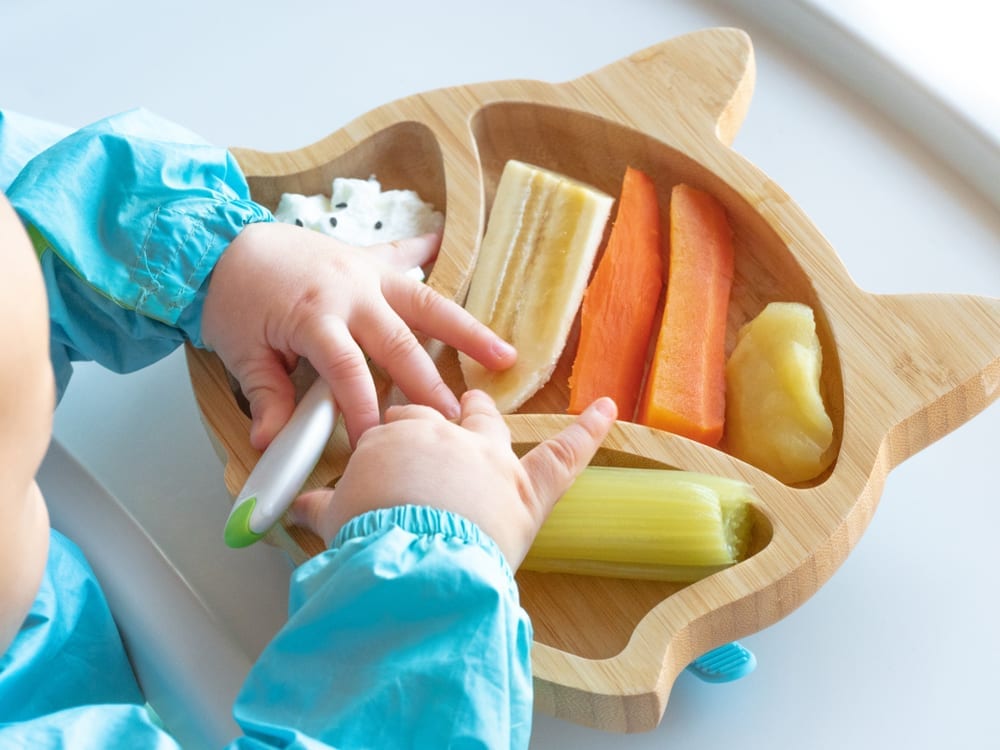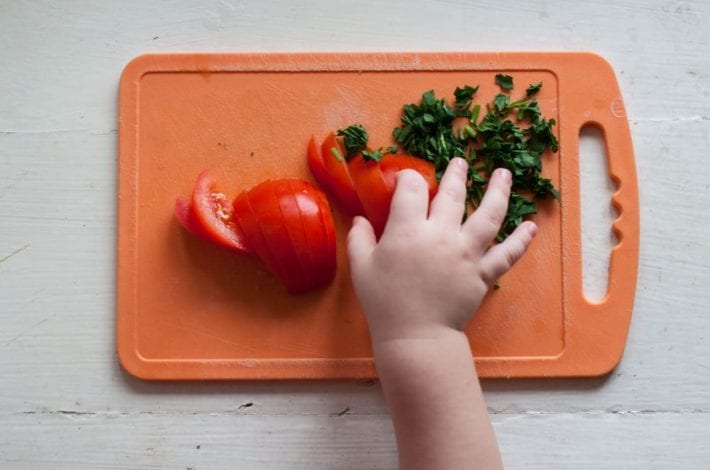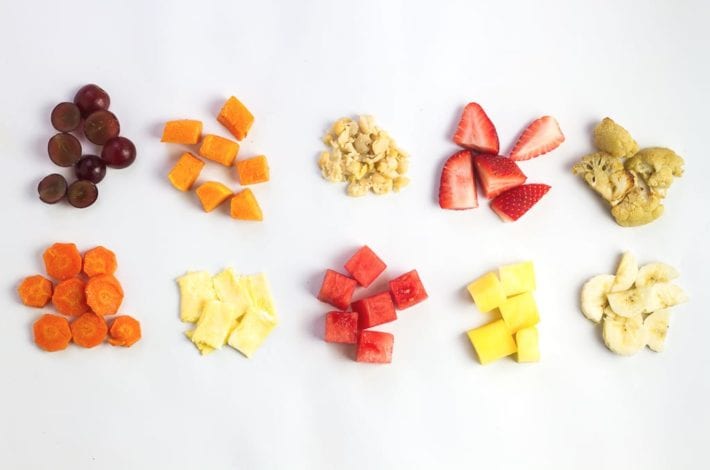BLW First Foods
Starting finger foods is an exciting time on your baby’s weaning journey. Through baby led weaning they can discover all sorts of new tastes and textures. They will also enjoy being able to feed themselves. It’s a messy business but it’s great fun too!
We’ve put together a list of top 30 BLW first foods below to get started with baby led weaning.
When Can I Start Baby Led Weaning?
You can give your baby finger foods right from the first bite, when they are 6 months old, if they can do certain things.
Your baby is ready to try finger foods when:
- He can sit unaided in a high chair.
- He can ‘chew’, using his gums to mash food.
- He has developed the ‘pincer grip’ so he can pick up objects and guide them to his mouth.
Babies shouldn’t be given finger foods before 6 months of age. As with any weaning method, babies should always be supervised when eating.
Combined Weaning: Baby Led Weaning AND Purees
Another way to begin, is to give baby soft finger foods alongside a puree. This has the advantage of allowing your baby to explore finger foods while also mastering spoon feeding and getting nutrition from the purees.
Over time you then phase out the purees and carry on with just the finger foods. Different ways work for different babies so it’s up to you how you prefer to start.
What Foods Should I Introduce First?
Babies are encouraged to try all sorts of different finger foods, to get them used to a variety of tastes and textures.
We’ve included our top 30 baby led weaning starter foods below. If you want a stage by stage break down of BLW first foods you can also see our complete list: Baby led weaning foods by age.
If your family dinner is made with mild, ‘ordinary’ ingredients, you can often offer some of this to baby. Keep it free from salt and pepper seasoning, cut off pieces from the food you are serving the rest of the family and offer it as finger food. For example, if you’re having a roast dinner you could give them roasted carrot batons and little strips of soft chicken.
The goal at the start is to introduce your child to as many different foods as you can, one by one, to gradually widen their palette.
Top 30 Baby Led Weaning Starter Foods
Baby Led Weaning Vegetables
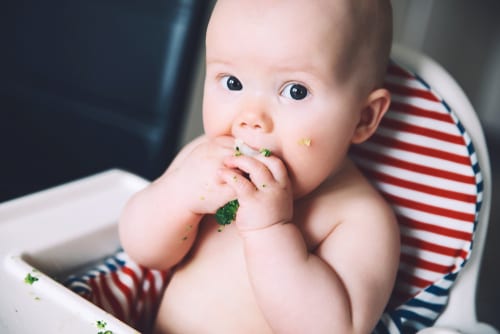 Your baby can eat the rainbow with colourful vegetables.
Your baby can eat the rainbow with colourful vegetables.
You can start by serving them plain. Or you could add mild herbs or spices and a little olive oil to introduce more flavours.
We always recommend that vegetables are soft and mashable for baby’s gums.
And that they are cut correctly for baby led weaning finger foods. See our guide: How to Cut Foods for Baby Led Weaning.
Carrots
Peel carrots and then boil or steam them. They can be chopped into batons or into soft chunks that baby can grab.
If you prefer you can also roast carrots in a little oil to give them a different taste and texture for baby to explore.
Sprinkle roast carrots with chopped parsley or thyme if you want to add some flavors.
Broccoli
Boil or steam your broccoli and then cut it into small pieces or skinny florets.
Broccoli florets are great for baby to grab as they can hold onto the stem and work at eating the top.
Sweet Potatoes
Peel and cut your sweet potatoes into long, thin batons. Either steam them or roast in a little oil.
Oregano or a pinch of ground cinnamon work well with sweet potatoes too.
Peas
Boil the peas for a few minutes until soft.
A fun way to serve them is to pop them into a colourful cupcake case.
Courgette
Peel, steam and chop your courgette into long pieces.
You could also saute batons of the courgette in a pan with some olive oil or coconut oil.
Just remember to peel the courgette first as the skin can be quite acidic and can affect some babies’ tummies.
Butternut Squash
Peel and cut your squash into batons and roast the pieces in the oven with a little oil. Or you could pop them in the steamer and cook until soft.
Butternut squash goes well with a little thyme, rosemary or cinnamon if you want to add some new flavours.
Green Beans
Steam and chop your green beans into pieces.
Remember to remove any stringy bit before you give them to your baby. You can drizzle green beans with olive oil.
Cucumber
You can peel the cucumber, cut into thin batons or small pieces and serve it raw. Easy.
Parsnip
Parsnip is a great food to peel and cut into thin fingers for roasting. You can add a pinch of thyme for extra flavour.
You can also steam it for 15 minutes until soft.
Pumpkin
Roast your pumpkin in the oven until nice and soft. Cut out the flesh into thin batons or little pieces.
You could add a pinch of rosemary, thyme, or cinnamon to give it some aromatic flavours if you would like to.
Baby Led Weaning Fruits
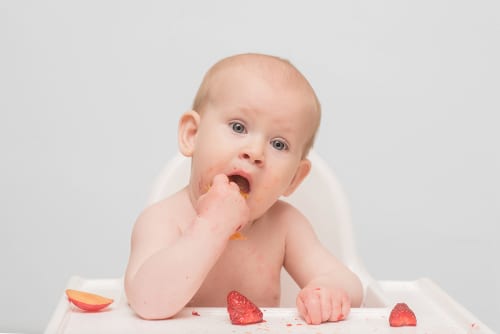
Fruit is always a winner as babies have a natural sweet tooth.
Make sure the fruit is peeled, soft and mashable before you give it to your baby.
Here are some fab first fruit finger foods to try.
Blueberries
These can be washed, chopped and served raw.
Remember to cut your blueberries into halves or quarters to reduce the risk of choking. As they are perfectly round they shouldn’t be served whole.
Apple
Peel and cut your apple into slices or little chunks and steam until soft.
You could even roast some pieces with cinnamon and oil for a baby treat.
Peaches
Simply peel and cut your peaches into thin slices or little pieces.
If it’s nice and ripe it will be soft enough for your baby to mash with their gums without the need for cooking. You may need to steam it first if it’s still quite firm.
Avocado
Did you know avocado was a fruit?
This is another easy no-cook food to prepare.
Pick a soft, ripe avocado. Simply scoop out the flesh and cut it into small slices or long batons.
Pear
Peel and cut a soft, ripe pear into batons or little pieces to offer raw. If it’s firm you could steam it for 5-10 minutes before serving.
For roasted pear, you can coat slices of pear in a bit of oil and cinnamon and bake them in the oven for half an hour.
Banana
Peel and chop a ripe banana into small pieces.
Banana is a surprising choking hazard as it does become a thick paste in baby’s mouth that they can’t manage.
Make sure baby doesn’t take large bites out of it, or have too much in their mouth at once. Instead serve it in small pieces.
Mango
Peel and chop a ripe mango into thin batons or little chunks.
If it’s firm you can steam it for a 5 minutes first.
Nectarine
Peel and cut your ripe nectarine into thin slices or little squares. If it’s not completely soft, you can steam the pieces for 5-10 minutes first.
Plums
Peel and cut ripe plums into small chunks for baby to enjoy.
Baby led weaning meat and fish
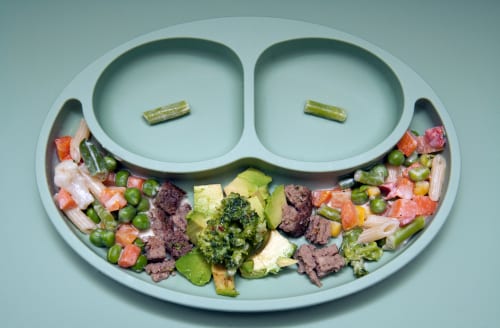


There are so many tasty ways you can introduce your baby to the different tastes and textures of white meats and fish.
Here are some great ideas for first meat and fish finger foods to give alongside vegetables and fruit.
Chicken
Roast, bake or grill chicken and then cut it into thin strips or little pea sized chunks.
Try to make it as soft and tender as possible.
It’s also always a good idea to double check the chicken is cooked through and not pink inside before offering some to baby.
Turkey
Roast or grill your turkey with herbs and cut it into small pieces to offer to baby.
White fish
Bake white fish in the oven until it’s soft and flaky.
Make extra sure there are no tiny bones hiding anywhere by checking it with a fork before giving to baby.
Salmon
Salmon can be baked or poached until soft and then broken up into pieces.
Again, take a look to make sure there are no bones before giving to your baby.
Baby Led Weaning Grains and Carbs
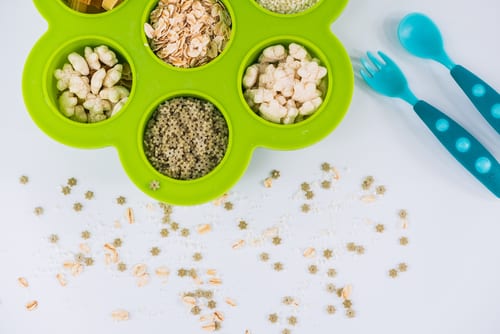


Here are some top baby led weaning grains and carbs to add to their meals.
Rice
Boil rice and then, when it’s a little cooled, clump it in your hands to make mini rice balls.
You can add peas or other chopped vegetables to the mix too to make your rice balls more interesting.
Oatmeal
Oats are a great first food for baby. You could serve it as an oatmeal cereal breakfast with some mashed banana or steamed apple. Or as tasty finger biscuits.
Our oatmeal recipe: Homemade banana teething rusks, finger biscuits with all natural ingredients.
Couscous
Couscous only needs to sit in boiling water for 5 minutes. When it’s done let it cool and fluff it out with a fork. You may need to help your baby to eat this one so that it doesn’t go everywhere.
You can add some vegetable chunks, herbs or a bit of oil or butter to make it a meal all on its own.
Pasta
Simply boil until soft and serve pasta.
You can add some homemade basil pesto for extra flavour, or cook the pasta with other vegetables that baby is enjoying like butternut squash or green been pieces.
Our favorite pasta recipe: Pasta and Pea Pesto.
Barley
Boil your barley until soft. Let it cool and then serve.
You could add some chopped dill or parsley to it as well for a fresh herb taste.
Toast
Try to keep the bread a little soft and not too hard. Cut off the crusts and then chop your toast into skinny fingers.
Babies will love working their way around the pieces.
You could also cut off thin strips of pitta bread to serve as well.
Pancakes
Babies can have pancakes if they’re’ made with simple ingredients. If you make a batch you can then cut them up into thin fingers for baby to eat.
Our favorite pancake recipe: 3 Ingredient Banana Pancakes for Baby.
Ready to Start Baby Led Weaning?
We hope these 30 Baby led weaning starter foods have given you some inspiration to begin your weaning journey.
Remember to keep offering baby a wide variety of foods and try to keep up a mix of vegetables, fruit, meat and grains.
Don’t worry if your little one turns his nose up at some foods. Just offer them again in a few days’ time.
It can take several tries to like a new food so don’t give up, And we hope you and baby enjoy the journey into the wonderful world of food!
Baby Led Weaning Choking Concerns
A common concern when parents start giving their baby solid foods, is the fear of choking. It’s a real worry and can make you scared to start giving your baby finger foods.
A study carried out in 2016 found that there is no greater risk of babies choking if they do baby led weaning compared to babies who start with purees.
That said, all babies should be closely supervised when they start weaning and never left alone while eating, even for a minute.
There are some more guidelines which can help reduce the risk of choking: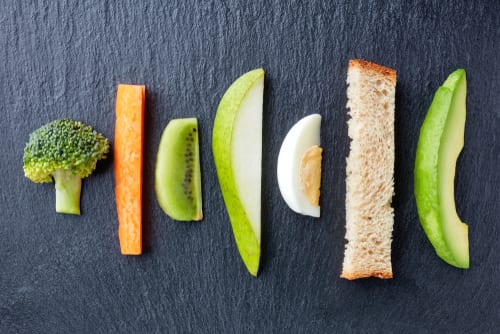


Start with Soft Finger Foods
It’s best to start with soft finger foods that can melt in baby’s mouth. This is so that they can mash them with gums.
Peel and chop the fruit and vegetables and cook them until they are soft and chewable.
The softness test
To test it to see if your baby’s food is soft enough, place the food in your mouth and see if you can easily mash it. You can only use your tongue to push the food onto the roof of your mouth (no teeth!).
Avoid Foods that are Choking Hazards for Toddlers and Babies
Never serve foods that are round and could get stuck in your baby’s air pipe.
So avoid foods like whole grapes, whole cherry tomatoes, whole cherries and whole nuts.
Hard foods like raw carrot and apple are also a choking risk. Always peel, chop and cook until soft before serving.
Foods that can swell in the throat after chewing are a relatively new choking risk that we are becoming aware of.
So take care with foods like banana and melon. Make sure you cut them into small pieces before giving them to your baby, so that they don’t have too much of them in their mouth at one time.
Other foods that are best to avoid for small babies and toddlers due to the risk of choking include hot dog sausages, popcorn and marshmallows.
The Difference Between Gagging and Choking
Lots of babies gag when they start eating solids. This can be alarming for parents but it is not the same as choking.
Gagging can sound worrying but it’s a natural reflex. It’s how your baby brings bigger lumps of food from the back of his throat to the front of his mouth, so that he can mash them down again.
A key rule of thumb is that:
Gagging is noisy but choking is silent (or quiet) which is why it is so important to keep a close eye on your baby as they eat.
If they eat a round piece of food that blocks their airway then they can choke. A baby who chokes is often unable to cry, cough, make any loud noises or even breathe. If your baby chokes then it’s important to act quickly.
What To Do If Your Baby Chokes
There are a number of things you can do to prevent choking. This is like supervising baby when they’re eating, taking care to offer safe foods and preparing foods correctly for baby so that they’re soft and manageable.
If the worst happens though and they do choke, it’s good to know what to do.
A bit of research done ahead of time can make all the difference. You could find a local first aid course to help you gain valuable skills.
There are also a number of useful first aid videos online, like the one above, that explain what to do. First aid articles like this one from the British Red Cross: First aid for a baby who is choking can also be found online.
It’s always worth being prepared to act if the worst happens. We hope that it never does and that you and baby can enjoy a great journey through food together.
How to Cut Finger Foods for Baby Led Weaning
It can be a good idea to make finger food into batons for baby. These are great if they’re long enough for your baby to pick up and grasp in their fist, and thin enough that they don’t get stuck in their windpipe.
Alternatively you can cut up food into small pieces for your baby to pick up and chew.
Rule of thumb for chopping finger foods
Use the rule of thumb to guide you when you chop food. Everything should be cut smaller than a thumb’s width before it is served to babies and young children.
For small pieces, they should be about the size of a chickpea.
Your baby might have their own preference for how their food is cut. Some like thin sticks, others like little chunks. Try both and see what works best for them.
For more on how to cut foods along with demonstrations, you can see our guide: How to Cut Foods for Baby Led Weaning.



Do you have a question about Baby Led Weaning?
Join our free online community forum:
Baby Led Weaning Forum
Feel free to ask anything at all.

